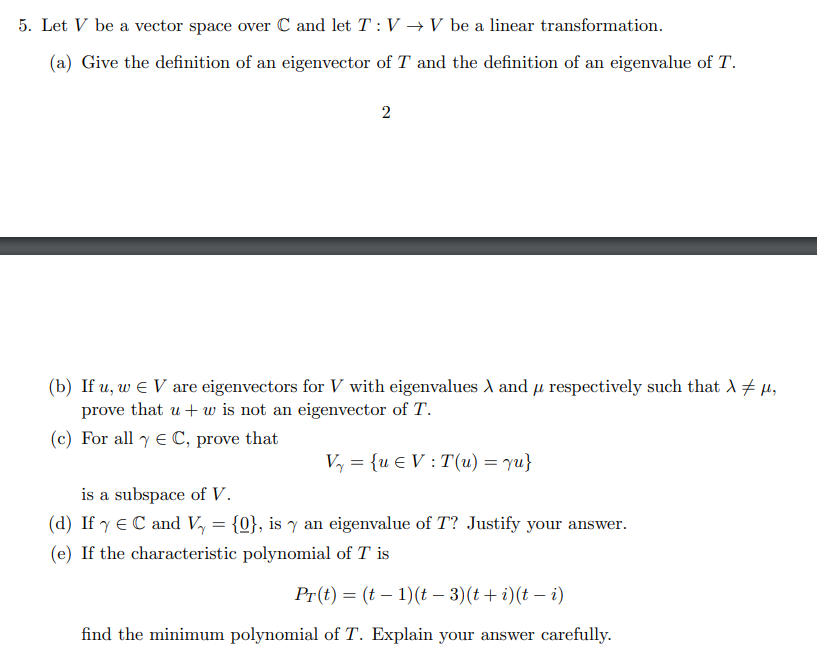5. Let V be a vector space over C and let T : V →V be a linear transformation. (a) Give the definition of an eigenvector of T and the definition of an eigenvalue of T. 2 (b) If u, w E V are eigenvectors for V with eigenvalues d and µ respectively such that A + µ, prove that u+ w is not an eigenvector of T. (c) For all y E C, prove that Vy = {u € V : T(u) = yu} is a subspace of V.
5. Let V be a vector space over C and let T : V →V be a linear transformation. (a) Give the definition of an eigenvector of T and the definition of an eigenvalue of T. 2 (b) If u, w E V are eigenvectors for V with eigenvalues d and µ respectively such that A + µ, prove that u+ w is not an eigenvector of T. (c) For all y E C, prove that Vy = {u € V : T(u) = yu} is a subspace of V.
Linear Algebra: A Modern Introduction
4th Edition
ISBN:9781285463247
Author:David Poole
Publisher:David Poole
Chapter6: Vector Spaces
Section6.6: The Matrix Of A Linear Transformation
Problem 25EQ
Related questions
Question

Transcribed Image Text:5. Let V be a vector space over C and let T : V →V be a linear transformation.
(a) Give the definition of an eigenvector of T and the definition of an eigenvalue of T.
2
(b) If u, w E V are eigenvectors for V with eigenvalues d and µ respectively such that A + µ,
prove that u+ w is not an eigenvector of T.
(c) For all y E C, prove that
Vy = {u € V : T(u) = yu}
is a subspace of V.
(d) If y E C and Vy = {0}, is y an eigenvalue of T? Justify your answer.
(e) If the characteristic polynomial of T is
Pr(t) = (t – 1)(t – 3)(t+ i)(t – i)
find the minimum polynomial of T. Explain your answer carefully.
Expert Solution
This question has been solved!
Explore an expertly crafted, step-by-step solution for a thorough understanding of key concepts.
Step by step
Solved in 3 steps with 2 images

Recommended textbooks for you

Linear Algebra: A Modern Introduction
Algebra
ISBN:
9781285463247
Author:
David Poole
Publisher:
Cengage Learning

Elementary Linear Algebra (MindTap Course List)
Algebra
ISBN:
9781305658004
Author:
Ron Larson
Publisher:
Cengage Learning

Linear Algebra: A Modern Introduction
Algebra
ISBN:
9781285463247
Author:
David Poole
Publisher:
Cengage Learning

Elementary Linear Algebra (MindTap Course List)
Algebra
ISBN:
9781305658004
Author:
Ron Larson
Publisher:
Cengage Learning